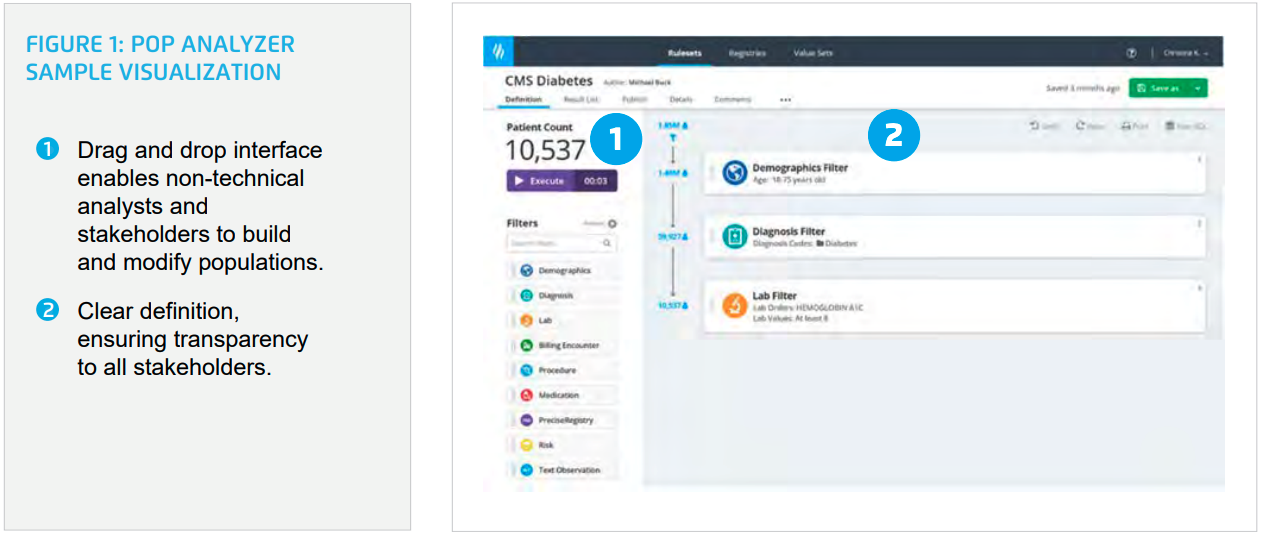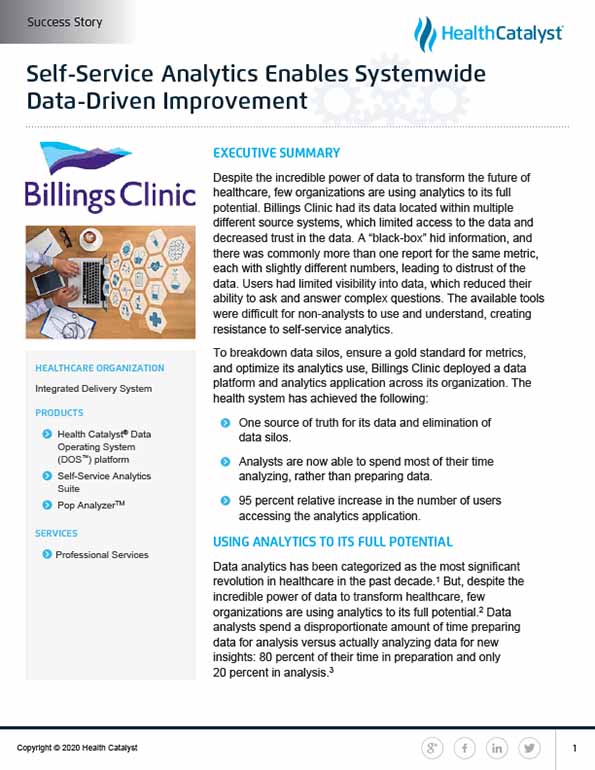Billings Clinic faced challenges with data accessibility and trust in the data due to reliance on multiple source systems. To address these challenges, the organization introduced a unified data platform and analytics application, breaking down silos, standardizing metrics, and making analytics more accessible and valuable for users across the organization.
Despite the incredible power of data to transform the future of healthcare, few organizations are using analytics to its full potential. Billings Clinic had its data located within multiple different source systems, which limited access to the data and decreased trust in the data. A “black-box” hid information, and there was commonly more than one report for the same metric, each with slightly different numbers, leading to distrust of the data. Users had limited visibility into data, which reduced their ability to ask and answer complex questions. The available tools were difficult for non-analysts to use and understand, creating resistance to self-service analytics.
To breakdown data silos, ensure a gold standard for metrics, and optimize its analytics use, Billings Clinic deployed a data platform and analytics application across its organization.
Data analytics has been categorized as the most significant revolution in healthcare in the past decade.1 But, despite the incredible power of data to transform healthcare, few organizations are using analytics to its full potential.2 Data analysts spend a disproportionate amount of time preparing data for analysis versus actually analyzing data for new insights: 80 percent of their time in preparation and only 20 percent in analysis.3
Billings Clinic, Montana’s largest healthcare organization, is a physician-led, integrated multispecialty group practice that includes hospitals and affiliates throughout Montana and Wyoming. The organization consistently earns national recognition for excellent performance in patient quality, safety, and service.
Billings Clinic understood that data, and the advanced capabilities to analyze and visualize data, was essential to its future, and critical for supporting the organization’s efforts to optimize population health. The health system identified the need for timely, consistent, accurate, easily accessible data to understand performance and improve outcomes for the patients it serves.
Despite recognizing the value of data, Billings Clinic was using a legacy data warehouse and analytics tools that limited its effectiveness. Rather than using their skills to analyze data and generate new insights, the organization’s analysts were spending the bulk of their time (up to 80 percent) pulling, cleansing, manipulating, and formatting data. The analytics team simply couldn’t answer all questions, as it would take too long in the legacy data warehouse or was too difficult to answer using the EMR data structure.
Billings Clinic had siloed data located in multiple different source systems, limiting access to the data and decreasing trust in the data. A “black-box” hid information, and more than one report often existed for the same metric, each with a slightly different number, leading to further distrust of the data. Users had limited visibility into data, which reduced their ability to ask and answer complex questions. Furthermore, the available tools were difficult for non-analysts to use and understand, creating resistance to self-service analytics, resulting in an increase of reports in the services request queue and slow turnaround times.
The organization wanted to accelerate population health improvements, with the goal of providing analytics support to all of its affiliates. Only two of those affiliates, however, had data in the legacy data warehouse, and analysts were already spending hundreds of hours annually to troubleshoot bad data. To improve patient outcomes well into the future, Billings Clinic needed a different analytics solution.
To meet its analytics needs, Billings Clinic adopted the Health Catalyst® Data Operating System (DOS™) and Self-Service Analytics Suite. DOS combines and standardizes data across source systems to provide actionable insights in a single technology platform.
Billings Clinic engaged stakeholders in prioritizing the data sources that would be the most valuable to integrate into the data platform. Stakeholders elected to integrate data from six different sources, including claims data from multiple source systems, cost data, financial data, clinical data, and patient satisfaction data into its data platform, creating a one solution for all of its data needs.
The Self-Service Analytics Suite is a collection of analytics infrastructure components. It provides reusable, curated, customizable analytics building blocks called DOS Marts™ and a visual builder tool called Pop Analyzer™, which allows the creation and sharing of population definitions without the use of complex SQL.
Billings Clinic leverages the data platform and analytics application to provide ready access to data to users across the entire organization—including analysts, clinicians, finance experts, and members of the leadership team. With the analytics application, team members can perform basic analytics and access comprehensive data from the various source systems in a manner never previously available to them.
The analytics application enables users to dynamically author, manage, view, and publish prebuilt and custom population ruleset definitions. It includes access to 400 nationally recognized populations, as well as quality improvement and regulatory code sets to build accurate populations faster (see Figure 1).

DOS and the Self-Service Analytics Suite relieve Billings Clinic analysts from having to reinvent the wheel for commonly used data elements. It enables self-service analytics by shifting much of the analytics development process from the analyst to the users/data consumers.
To optimize the use of the analytics application, Billings Clinic engaged teams in identifying and training users of the tool. The training addresses the unique needs of each service line and focuses on relevant use cases and the specific questions they want to answer. Users can immediately visualize various patient populations and answer previously unanswerable complicated questions.
When users are exposed to data in a new way during the training session, they often identify additional data they want to view. Billings Clinic analysts can make the requested enhancements immediately. Analysts reach out to new users approximately two weeks after the initial training to ensure users have adopted the analytics application and also inquire about any challenges.
Billings Clinic now has one source of truth for its data and has eliminated data silos. For the first time, the organization has reliable, accurate data it can use to answer specific questions about performance, generating new, actionable insights that can improve outcomes for its patients.
With a successful shift to self-service analytics, the organization has achieved a 95 percent relative increase in the number of users accessing the analytics application in just eight months. Users are leveraging improved data transparency and visibility to ask more complex questions than ever before.
Frontline staff now complete ad hoc requests, which used to take weeks and four different people, in less than thirty minutes. One department, for example, had worked for years to identify a specific group of patients who had received services but had not yet been billed; using the analytics application, Billings Clinic identified the patients in just 15 minutes.
Billings Clinic achieved additional significant improvements, including:
“Access to data is not enough. You have to be able to ask and answer specific clinical questions and need to use the answers to improve outcomes. Pop Analyzer is one of the most powerful tools for answering our questions, helping us use our data for outcomes improvement.”
– Randy Thompson, MD, FACEP, Chief Health Analytics Officer at Billings Clinic.
Billings Clinic will continue to expand its use of analytics, using its data to enhance quality measurement and improve patient outcomes. The organization will also extend its analytics services to all of its affiliates.


